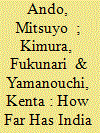|
|
|
Sort Order |
|
|
|
Items / Page
|
|
|
|
|
|
|
| Srl | Item |
| 1 |
ID:
192051


|
|
|
|
|
| Summary/Abstract |
This work assesses the impact of terrorism suffered by a country on the capacity to attract foreign greenfield investments. To this end, we estimate a theoretically consistent structural gravity equation which accounts for several well-known estimation biases such as ‘home bias’, endogeneity and multilateral resistance. This specification makes it possible to identify the effect of a country-specific time-varying characteristic such as terrorism on bilateral foreign direct investment. We exploit a dataset that covers domestic and foreign investment of 182 countries in the period 2006-2016 on both the extensive and intensive margins. Our study finds that foreign investors are reluctant to invest in countries affected by terrorism and also reduce the amount of their investments in such cases. Sensitivity to terrorism is higher for foreign than for domestic investors. Terrorist attacks have a more intense impact on foreign investors’ decision-making when they are international or when these violent acts hurt governments. However, our results also evidence that good governance appears to be an effective tool for counterbalancing these damages in the eyes of foreign investors.
|
|
|
|
|
|
|
|
|
|
|
|
|
|
|
|
| 2 |
ID:
173743


|
|
|
|
|
| Summary/Abstract |
This article argues that on balance globalization does not increase, and may even reduce, the opportunity cost of Militarized Interstate Disputes (MIDs), as measured by foregone merchandise trade. Specifically, globalization makes it easier for states to substitute trade partners, makes it difficult to employ trade sanctions, makes credit more available to states at conflict, and encourages trade-substituting horizontal Foreign Direct Investment (FDI) and sanctions-resilient vertical FDI. Hypotheses are supported using High Dimensional Fixed Effects regression, applied to a Gravity model, with two-way clustering of standard errors, and an analysis of the effect of globalization on the marginal effect of MIDs on international trade. This suggests that while wars are becoming infrequent in recent decades, due to other factors, trade’s contribution to peace is diminishing.
|
|
|
|
|
|
|
|
|
|
|
|
|
|
|
|
| 3 |
ID:
160635


|
|
|
|
|
| Summary/Abstract |
Over the past 30 years, Southeast Asia has experienced rapid growth in intra-regional economic activity, but despite the remarkable diminution in the frequency and intensity of military conflict and crises, it has not been free of interstate disputes, such as maritime disputes. However, the struggle against maritime crime activities such as maritime piracy is a priority for all countries of the region, as well as one of the unavoidable prerequisites for the achievement of the regional economic security. This research note focuses on the impact of maritime piracy on the Southeast Asian countries’ trade. Bilateral trade flows among the Southeast Asian countries over the 1994 to 2013 period are used to estimate an augmented gravity model that includes various measures of maritime crime activities. The purpose is to find the evidence to indicate how maritime piracy has affected the volume of intra-regional trade.
|
|
|
|
|
|
|
|
|
|
|
|
|
|
|
|
| 4 |
ID:
188445


|
|
|
|
|
| Summary/Abstract |
Since the 1990s, East Asia—including Northeast and Southeast Asia—has led the world in adopting a task-by-task international division of labour or international production networks (IPNs), the core of which consists of machinery industries. In this regard, how far has India integrated with East Asia? Using international trade data for comparison from multiple perspectives, this article gives an overview of the current position of India with respect to machinery IPNs and information and communication technology (ICT) services. The article shows that India has not yet participated in machinery IPNs in the East Asian region. We argue that ICT services are a source of strength for the Indian economy, and its competitiveness could be utilized effectively by combining new technologies with traditional industries such as manufacturing. India still has huge untapped opportunities for utilizing the mechanics of a new international division of labour to accelerate economic growth, innovation and poverty alleviation. And economic integration with East Asia could work as a trigger to redirect India’s industrialization strategies.
|
|
|
|
|
|
|
|
|
|
|
|
|
|
|
|
|
|
|
|
|